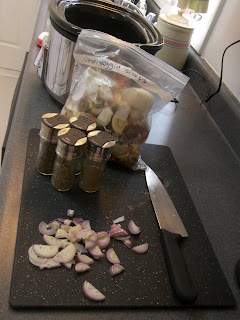- commute in a green/thrifty way (ride a bike, walk, carpool, take public transit, etc.)
- prepare a meal at home
- do something frugal
Are you up for the challenge? Make good on all those Earth Day resolutions you made last week!

The plus side of it all? (Besides the other things I mentioned before) A full freezer works more efficiently!
 trimmed the breasts, and sliced them for three different preparations: Kebabs, chunks, and cutlets. I labeled plastic bags accordingly, put the chicken in and a third of the marinade, and coated them before tossing them in the freezer.
trimmed the breasts, and sliced them for three different preparations: Kebabs, chunks, and cutlets. I labeled plastic bags accordingly, put the chicken in and a third of the marinade, and coated them before tossing them in the freezer. I know, it doesn't look as appetizing as the photos on food blogs -- you don't exactly want to lick these things off of your screen. The point is that there is no trimming, cubing, or keeping fresh herbs on hand to prepare three healthy meals at the last minute. In fact, Mr. Green already succumbed to temptation one night after we arrived home late and tired from work. Even from freezer to grill, the kebabs were delicious! (no thawing necessary)
I know, it doesn't look as appetizing as the photos on food blogs -- you don't exactly want to lick these things off of your screen. The point is that there is no trimming, cubing, or keeping fresh herbs on hand to prepare three healthy meals at the last minute. In fact, Mr. Green already succumbed to temptation one night after we arrived home late and tired from work. Even from freezer to grill, the kebabs were delicious! (no thawing necessary) I love to cook, but I love to cook in great quantities even more, because then I don't have to cook as much. I know it seems like a paradox, but you know what I mean ... I enjoy cooking, but I never want it to feel like a chore. Cooking for yourself also helps you control what, exactly, you eat and how it is prepared as well as the cost of it. Cooking in quantity saves the cook energy and saves the Earth's resources because cooking implements need only be rinsed between uses, if at all, and proper planning reduces wasted leftover ingredients that the cook doesn't typically use. Cooking in quantity also tends to reduce the cost of cooking because it allows cooks to buy in bulk.
I love to cook, but I love to cook in great quantities even more, because then I don't have to cook as much. I know it seems like a paradox, but you know what I mean ... I enjoy cooking, but I never want it to feel like a chore. Cooking for yourself also helps you control what, exactly, you eat and how it is prepared as well as the cost of it. Cooking in quantity saves the cook energy and saves the Earth's resources because cooking implements need only be rinsed between uses, if at all, and proper planning reduces wasted leftover ingredients that the cook doesn't typically use. Cooking in quantity also tends to reduce the cost of cooking because it allows cooks to buy in bulk.Links to other useful "freezer cooking" or "Once a Month Cooking" resources:
Savvy readers are probably already doing these things. If you are, you've saved a few bucks and might be able to find some room in your budget for the green options that will cost a few more dollars.
For our action item this month, Mr. Green and I decided that we are going to go organic on many of the foods that are widely acknowledged as dangerous -- to our health and our earth -- in their conventionally processed form. It's not quite in line with being a cheapskate, but we noticed that our penny-pinching in our food budget has led to some wiggle room that will allow us to buy the more pricey organic items. I'll let you know soon what those items are.


 I pulled the solids from the pot, pushed the water out of them using a colander,
I pulled the solids from the pot, pushed the water out of them using a colander, and had a delicious stock. Be sure to cool it down quickly before putting it in the fridge or freezer! I use freezer packs and a few ice cubes.
and had a delicious stock. Be sure to cool it down quickly before putting it in the fridge or freezer! I use freezer packs and a few ice cubes.

